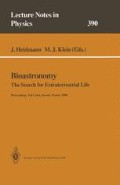Abstract
We have developed a model to investigate the duration of conditions necessary for the origin of life on a Mars-like planet. We investigate various star-planet distances and a range of stellar spectral types in order to provide guidance for the Search for Extraterrestrial Intelligence (SETI). We consider planets suitable for the origin of life if they contain liquid water habitats for time periods comparable to the maximum time required for the origin of life on Earth. A Mars-like planet will differ from an Earth-like planet primarily because it will have no plate tectonic activity and therefore no long-term recycling of CO2 We find that there is sufficient time for the origin of life on Mars-like planets around F, G, K, and M type stars. In addition, we find that Mars-like planets with an initial insolation less than the present insolation on Mars have the greatest potential for the origin of life.
Access this chapter
Tax calculation will be finalised at checkout
Purchases are for personal use only
Preview
Unable to display preview. Download preview PDF.
References
Allen, C.W., 1976, Astrophysical Quantities (Humanities Press Inc., New Jersey), 249.
Carr, M.H., Recharge of the early atmosphere of Mars by impact-induced release of CO2, Icarus 79, 311–327, 1989.
Cess, R.D., V. Ramanathan, and T. Owen, The martian paleoclimate and enhanced carbon dioxide, Icarus 411, 159–165, 1980.
Dott, Jr., R. H., and R. L. Batten, 1988, Evolution of the Earth (McGraw-Hill, New York).
Doyle, L., and C.P. McKay, Exobiological Habitats: An overview, (this volume), 1991.
Hart, M.H., Habitable zones about main sequence stars, Icarus 37, 351–357, 1979.
Iben, I., Stellar evolution VI. Evolution from main-sequence to the red-giant branch for stars of mass 1 M⊙, 1.25 M⊙, and 1.5 M⊙. Astrophysical Journal 147, 624, 1967.
Kasting, J.F., and T.P. Ackerman, Climatic consequences of very high CO2 levels in Earth's early atmosphere, Science 234, 1383–1385, 1986.
Lin, D.N.C., and J. Papaloizou, On the dynamical origin of the solar system, in Protostars & Planets II, D. Black and M.S. Matthews, eds., 981–1072, 1985.
McKay, C.P., G.A. Clow, R.A. Wharton, Jr., and S.W. Squyres, Thickness of ice on perennially frozen lakes, Nature 313, 561–562, 1985.
McKay, C.P., and W.L. Davis, Duration of liquid water habitats on early Mars, Icarus, in press 1991.
McKay, C.P., and S.S. Nedell, Are there carbonate deposits in Valles Marineris, Mars?, Icarus 73, 142–148, 1988.
McKay, C.P., and C.R. Stoker, The early environment and its evolution on Mars: implications for life, Reviews of Geophysics 27, 189–214, 1989.
Moroz, V.I., and L.M. Mukhin, Early evolutionary stages in the atmosphere and climate of the terrestrial planets, Cosmic Research 15, 774–791, 1977.
Owen, T., R.D. Cess, and V. Ramanathan, Enhanced CO2 greenhouse to compensate for reduced solar luminosity on early Earth, Nature 277, 640–642, 1979.
Parker, B.C., G.M. Simmons, Jr., K.G. Seaburg, D.D. Cathey, and F.C.T. Allnut, Comparative ecology of plankton communities in seven Antarctic oasis lakes, J. Plankton Res. 4, 271–286, 1982.
Pollack, J.B., J.F. Kasting, S.M. Richardson, and K. Poliakoff, The case for a wet, warm climate on early Mars, Icarus 71, 203–224, 1987.
Wharton, Jr., R.A., C.P. McKay, G.M. Simmons, Jr., and B.C. Parker, Oxygen budget of a perennially ice-covered Antarctic dry valley lake, Limnol. Oceanogr. 31, 437–443, 1986.
Wharton, Jr., R.A., C.P. McKay, R.L. Mancinelli, and G.M. Simmons, Jr., Perennial N2 supersaturation in an Antarctic lake, Nature 325, 343–345, 1987.
Whitmire, D.P., R.T. Reynolds, and J. F. Kasting, Habitable Zones for Earth-like Planets around main sequence stars, (this volume), 1991.
Author information
Authors and Affiliations
Editor information
Rights and permissions
Copyright information
© 1991 Springer-Verlag
About this paper
Cite this paper
Davis, W.L., Doyle, L.R., Backman, D.E., McKay, C.P. (1991). The habitability of Mars-like planets around main sequence stars. In: Heidmann, J., Klein, M.J. (eds) Bioastronomy. Lecture Notes in Physics, vol 390. Springer, Berlin, Heidelberg. https://doi.org/10.1007/3-540-54752-5_189
Download citation
DOI: https://doi.org/10.1007/3-540-54752-5_189
Published:
Publisher Name: Springer, Berlin, Heidelberg
Print ISBN: 978-3-540-54752-5
Online ISBN: 978-3-540-46447-1
eBook Packages: Springer Book Archive

